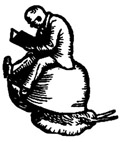elegy el que más te guste
Eccentric(ity)—that which inhabits outside the center—is one of the masks that the city of La Plata flaunts. Its energy does not remain in the shade of the Plata´s giant, Buenos Aires. In spite of being located just a few kilometers outside the larger city's field of attraction, La Plata retains a bubble-like atmosphere that could be the microscopy, the mise en abyme, of an alternative view on life made up of ec-centric aspects of the system ruling the whole country.
Editorial pole, cannabical pole, and agent of the regional homegrown culture, La Plata sets the trend in cutting-edge artistic languages. The street variables of graffiti (Arens), image and geometry, concept and color (ACRA CREW): the continuous scuffle of mottos, political footballing emblems, the stencil that serves for the quick on-going presence of the Bellas Arte´s population. The careers of Art—music, cinema, the plastic arts—and Philosophy have been developing a self-conscious artistic view, a common identity that refreshes and updates herself with the successive flow of students that year on year arrive to encourage the student´s movement, historic among the platenses, and with great significance to the Argentinean history. These political groups actively intervene in the socio-political and artistic debate of their surroundings.
But as Borges says in his story “El Sur”: “Reality likes symmetries and minor anachronisms.” La Plata seems to contradict the master, because reality here is asymmetric. and its anachronisms powerful. Built over its Masonic ancestry, the urban layout is a perfect checkerboard ripped by diagonals that lead to shifted, twisted corners and byways. It is common for visitants to “get lost” by taking these diagonals, and at the same time, they “find themselves,” out of the blue, in front of an unexpected landscape that can include gargoyles, gothic deviations, and palazzos with colonial balconies or esoteric statues that show enigmatic symbols in their hands.
Every six streets or so a park stands, full of hundred-year-old trees with violet, amber, and magenta shades… the basements turned into wineries and the caves of night pubs… the effervescence of the under-movement that shelters itself under the stone pavement of the streets, and in the grey area of the law… the burning of effigies at New Year´s Eve… the fairs and literary lides… the non-ending recitals of independent bands that spread the rock legacy of Virus and Los Redondos… all are phenomena that turn the media models to a second level, favoring the emergence of a new hungry-for-culture subject.
Only a few have had access to the tunnels, which makes their legend grow even more. In this case, the subterranean paths are old communication, escape and contraband channels, designed by the architects of the founder, Dardo Rocha, a Freemason who boosted the use of compass and trowel. Some tunnels end in the train stop stations that connect to the port on the River Plate.
The University, the true radioactive nucleus of the city, mixes with foreigners (most Latin-American) and incites a linguistic humus, intensively cosmopolitan, that not only seems to be a jewel for academics, but a festival for the arts. The colloquial branches of our language join the urban tribes with the rest of pre-modern villages that the (neoliberal) migration flood left. This link to the great academic center is a key element that supports the explosion of boiling minds.
The poetry which results (Straccali, Vdodicheko), the essays (Dubin), and the narratives (Campanaro, Magallanes, Kruppa), are unsurprisingly eccentric texts, as incongruous in the mainstream as they are foreign to the sticky homo academicus elites. |

